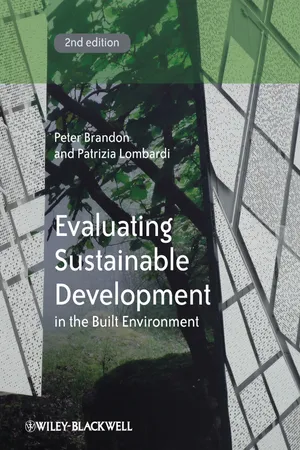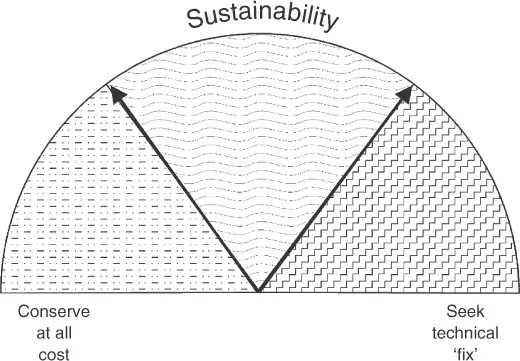![]()
1
Setting the Context for Evaluating Sustainable Development
The environmental perspective
The subject of sustainable development is one of the key research and policy issues as we enter the early years of the twenty-first century. This book takes the broad view, but the world focus at the time of writing appears to be the concerns on climate change and on pollution levels threatening the survival of the human species. The importance of this focus can be seen by the high regard that the global community places on these problems. At the Rio conference in 1992, 100 heads of states attended, representing 179 governments that committed themselves to an agenda for addressing the perceived problem. In 2002, 109 governments were represented at the Rio + 10 conference in Johannesburg and vowed to continue the focus on what they considered to be an important area. More recently, the Kyoto Protocol regarding carbon emissions has been ratified by most of the countries of the world and the Copenhagen World Summit on climate change has committed itself to an accord to prevent the rise in global temperature going beyond a further 2°C (although this was not made legally binding). This is the maximum that experts feel the world can accommodate without major catastrophe, although many will still suffer. Over the past 5 years the European Union has committed a substantial proportion of its research and development monies to sustainability issues and the majority of governments that have a national research programme have also committed funds to the cause. So why the interest and why is it at, or near, the top of global policy for research and development?
With all new ideas, there is a long gestation period before they are taken up as policy or identified as a key issue for researchers to address. There is little doubt that the current interest in sustainable development has come from the pressure groups and particularly those associated with the green movement who saw the depletion of non-renewable resources (and particularly energy stocks), the pollution of the air and water and the breakdown of social conscience through globalisation as leading to the demise of mankind and the balance of nature (the ecosystem), which presently sustains living creatures. They considered that there was a moral imperative to take the long-term view and to consider the impact of decisions taken now on generations that would follow. It is true to say that within this general thrust there was, and probably will be, a variety of opinions on such matters as the extent of the damage being done to the environment, the responsibility for the current situation and the manner in which it can be remedied.
There is, however, a growing consensus that something is wrong and that mankind has a duty to do something about it. There has been a crescendo of concern from almost every quarter of human society led by some very significant figures in government, academe and pressure organisations. These are the new prophets, forecasting a calamity and demanding that the world turn from its fallen ways! In nearly all cases, their forecasts have been on the conservative side in recent years, particularly with regard to global warming. It appears that the world is getting warmer at a faster rate than was expected, that it appears to be accentuated by the behaviour of mankind and that humankind is facing a losing battle to remedy the situation. Hence, the focus on resilience (i.e. the ability to retain function through adversity) to assist in containing the problem. Leading thinkers and politicians such as Gore (2006), Lovelock (2009), Rees (2004), Jackson (2009) and many others have brought to the attention of the world the potential plight which faces life on earth.
Knowing what to do is of course another matter and there is a spectrum of views (see Fig. 1.1). At one end of the spectrum are those who suggest that we should conserve at all costs, change the way we live and seek a reduction in economic growth as a means of reducing consumption. At the other end are those who believe that necessity is the mother of invention and that a ‘technical fix’ will be found which will remove the need for such drastic measures to be taken. They believe that the markets will drive up the price of non-renewable resources and that this in turn will encourage innovators to provide sensible alternatives. Against this argument others would say that in the time it takes for the markets to realise what is happening, irreparable damage may have been done to the planet for which future generations may have to pay the full price.
These two extremes can also be viewed through the themes which arose from the Johannesburg Summit. There were two major schools of thought. One appeared to be arguing that man could exercise control and dominion over the earth, mainly by technological advancement. The other thought that humans must review their position as part of nature and seek to work in harmony and in empathy with the cycles of nature and the planet. This polarisation of view is often seen as detrimental to advancement and that much can be achieved by developing the technology whilst appreciating, respecting and recognising the second. There is a paradox in this dialogue because if we were not able to intervene then nature would probably have found ways to limit population growth (as it has with so many species) and avoid the excessive use of non-renewable resources. Population growth is at the heart of the problem – we cannot sustain this number of people with the resources available.
Despite this, much of this debate is at the level of the planet. Saving spaceship earth is the clarion call and we must all be engaged in the earth’s preservation and its delicate ecological systems. This attitude may also be debated, for many would point out that the earth has been in turmoil ever since its formation and species have come and gone, climatic changes far outweigh the actions of mankind in terms of their devastation and in the very long term the earth itself will disappear and will probably be engulfed in a black hole or other stellar catastrophe. The response to this would be that we are the first species able to create its own downfall and the first to be able to at least extend its sojourn on earth, so why should we not rise to the challenge and try to extend the life of the species? The focus is on the environment and it is through this filter that human activity will be judged. This does not seem unreasonable as future generations will probably judge the activities of the current generation in the same way that we often judge the misdemeanours of the past: by the way they affect us now.
The question of time is a key one and the text will return to this in due course. Over what period should we view sustainable development? It is a critical issue for the systems and techniques we employ to measure progress. If we take the very long term, the planet is probably doomed anyway. If we take the short term, we can probably muddle through and overcome or manoeuvre around the problems that we have created. How far ahead can we look? Is it one, two, several or hundreds of generations? Most commentators would suggest that our ability to make interventions that would aid future populations is limited to two or three generations. Beyond this, we would probably need to be prophets or exercise witchcraft to know what to do. Predictions made 200 years ago, extrapolating the knowledge of the time, seem naive and stupid with the benefit of hindsight. For example, it was thought that London would be waist-deep in horse manure at the turn of the nineteenth/twentieth century because of the growth of horse-drawn transport! Would it have been sensible to ask the people of Europe 300 years ago to sacrifice their gruel in order that our generation would benefit from having the asset of computer technology? Of course not.
There is perhaps one area where we can predict a potential problem and that is with the demise of non-renewable resources. Who knows of what value these resources will be to those who will follow? We do not know what benefits to health, to quality of life and to the supply of useful products these resources will bring, because our knowledge of their potential is still limited. We do not understand how they may be used in different, complex combinations linked to other knowledge, for example of the nature of genes, to the benefit of our children and beyond. If some of these resources disappear, what legacy are we leaving? We tend to view these resources in terms of what they can provide now and not what their potential benefit could be in the future. Our outlooks are determined by their impact on us and the horizons that science and technology have set fo...

